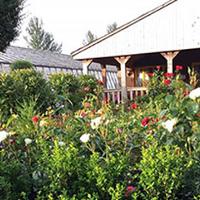How to attract pollinators to your garden all year round
Pollinators are essential to the health of our gardens and the wider environment. While bees often get the spotlight, butterflies, moths, hoverflies, beetles, and even wasps play crucial roles in pollinating fruit, vegetables, and flowers.
Encouraging pollinators into your garden isn't just good for nature, it helps your plants thrive too. And with the right planting choices, you can support them every month of the year.
Why Pollinators Need Our Help
Modern agriculture, pesticides, and habitat loss have led to declining numbers of pollinators. By planting the right flowers and providing food and shelter, gardeners can make a real difference, even in small urban spaces.
1. Choose the Right Flowers
Pollinators are drawn to flowers for nectar and pollen. However, not all flowers are created equal.
Avoid double-flowered varieties: These may look beautiful, but their extra petals often block access to nectar or lack it entirely.
Opt for open, single blooms: Plants like single dahlias, open-faced roses, and daisies are much easier for insects to feed from.
Go for diversity: A range of flower shapes, colours, and sizes helps attract different species.
2. Provide Year-Round Nectar
Pollinators need food from early spring through to late autumn, and even in winter during mild spells. Here's a seasonal guide to plants that help throughout the year in UK gardens:
Early Spring (February–April)
Pollinators emerge early in the year when food is scarce, so early bloomers are vital.
- Crocus
- Snowdrops (Galanthus)
- Hellebores
- Willows (Salix caprea)
- Lungwort (Pulmonaria)
Late Spring to Summer (May–August)
This is the peak time for flowering and pollinator activity.
- Foxgloves (Digitalis) – great for bees
- Alliums
- Lavender
- Catmint (Nepeta)
- Borage
- Cornflowers
- Wildflowers like red campion and birdsfoot trefoil
Autumn (September–November)
As days shorten, late-season flowers keep pollinators going longer.
- Sedum (Hylotelephium)
- Michaelmas daisies (Aster)
- Ivy (Hedera helix) – an autumn lifeline for bees and hoverflies
- Verbena bonariensis
Winter (December–January)
Pollinators are less active but may emerge on mild days. A few hardy plants help.
- Winter honeysuckle (Lonicera fragrantissima)
- Mahonia
- Witch hazel (Hamamelis)
- Heathers (Erica carnea)
3. Don't Forget Night Pollinators
Many moths are active at night and are important pollinators too. Fragrant, pale-coloured flowers attract them, such as:
- Evening primrose (Oenothera)
- Jasmine (Jasminum officinale)
- Night-scented stock
Moths also feed on ivy flowers in autumn, another reason to let it flourish.
4. Add Habitat and Shelter
Providing food is only part of the picture. Pollinators need safe places to shelter, nest, and overwinter.
- Leave some areas undisturbed with long grass or leaf litter.
- Install bee hotels for solitary bees such as mason and leafcutter bees.
- Avoid pesticides and herbicides, which harm pollinators and their food sources.
- Grow hedges or shrubs like hawthorn, holly, or dog rose, great for shelter and nectar.
5. Embrace a Natural Look
Pollinators thrive in slightly wilder gardens. You don't need to let your garden go to seed, but a relaxed approach helps:
- Let lawn clover and daisies bloom.
- Allow some weeds like dandelions to flower, they're early-season favourites for bees.
- Sow a wildflower patch or mix native wildflowers into borders for a natural boost.
Final Thoughts
Attracting pollinators to your garden is one of the most impactful ways you can support the environment, and it rewards you with vibrant blooms, buzzing life, and better harvests. By planting a wide variety of nectar-rich flowers, avoiding overly cultivated double blooms, and creating natural habitat, you'll turn your garden into a haven for pollinators all year round.
Visit Gardening World Limited for expert advice and a wide range of pollinator-friendly plants, seeds, and habitats. Let's help nature thrive, one garden at a time.




